[Note: This article was originally written July 30, 2023]
The International Festival is just a few days away. A couple of weeks ago we did a brief history of the international celebrations here in the St. Croix Valley which have included 50 years of International Festivals, many Queen’s Birthdays, Fourths of July, victory parades after the world wars, Memorial Days, centennials, bicentennials, etc.-the list is long. There was one celebration on the border which we forgot to mention although it marked one of the most significant events in the history of the St Croix Valley. The celebration occurred on a blustery, bitterly cold day in February 1894.
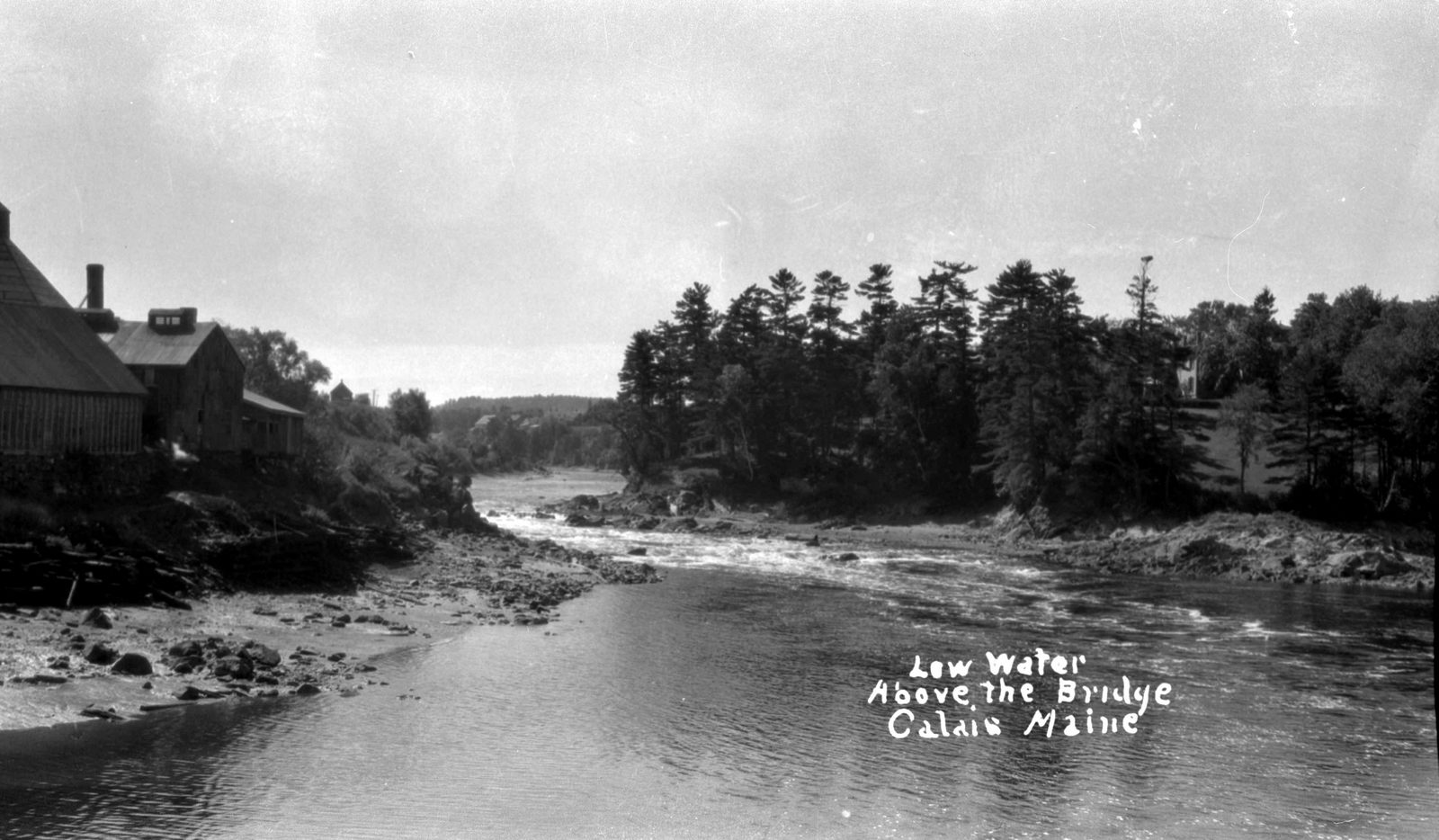
To the right Dover Hill, to the left the Calais shore. Photo taken from Ferry Point Bridge
While the towns of Calais, St. Stephen and the two Milltowns are joined together by marriage, commerce, social connections and strong friendships we are separated by a river, the St. Croix. While not the mighty Mississippi or even the formidable Kennebec, the St. Croix is no piddling stream. The only place the river can be crossed on foot is over the rapids just above the Ferry Point bridge and then only at low tide and at great peril to one’s life. Some have died attempting the crossing. In the 1970’s Ike Lee of Calais was barred from Canada for numerous transgressions on the Canadian side but had successfully avoided Canadian immigration officials on several occasions until he slipped on the slick rocks of the rapids and drowned. Swimming across the river is possible. Louis Morrison who grew up on Union Street described watching an older friend make several trips a night during Prohibition to the Canadian side, returning each trip with a 3 gallon can of 180 proof Belgium rum but swimming wasn’t an option for most people. What was needed were bridges.
In the early years of the settlement there were none. Folks crossed on the ferries operated by Isaac Hanson at Ferry Point and Jesse Haycock in Milltown. These were simply dugout canoes. Oddly, the first bridge constructed across the river in about 1820 did not cross the river from Calais to St. Stephen but from Baring to Upper Mills. This was of little benefit to Calais-St. Stephen residents a trip of 12 miles was required to reach a point just a few hundred feet across the river.
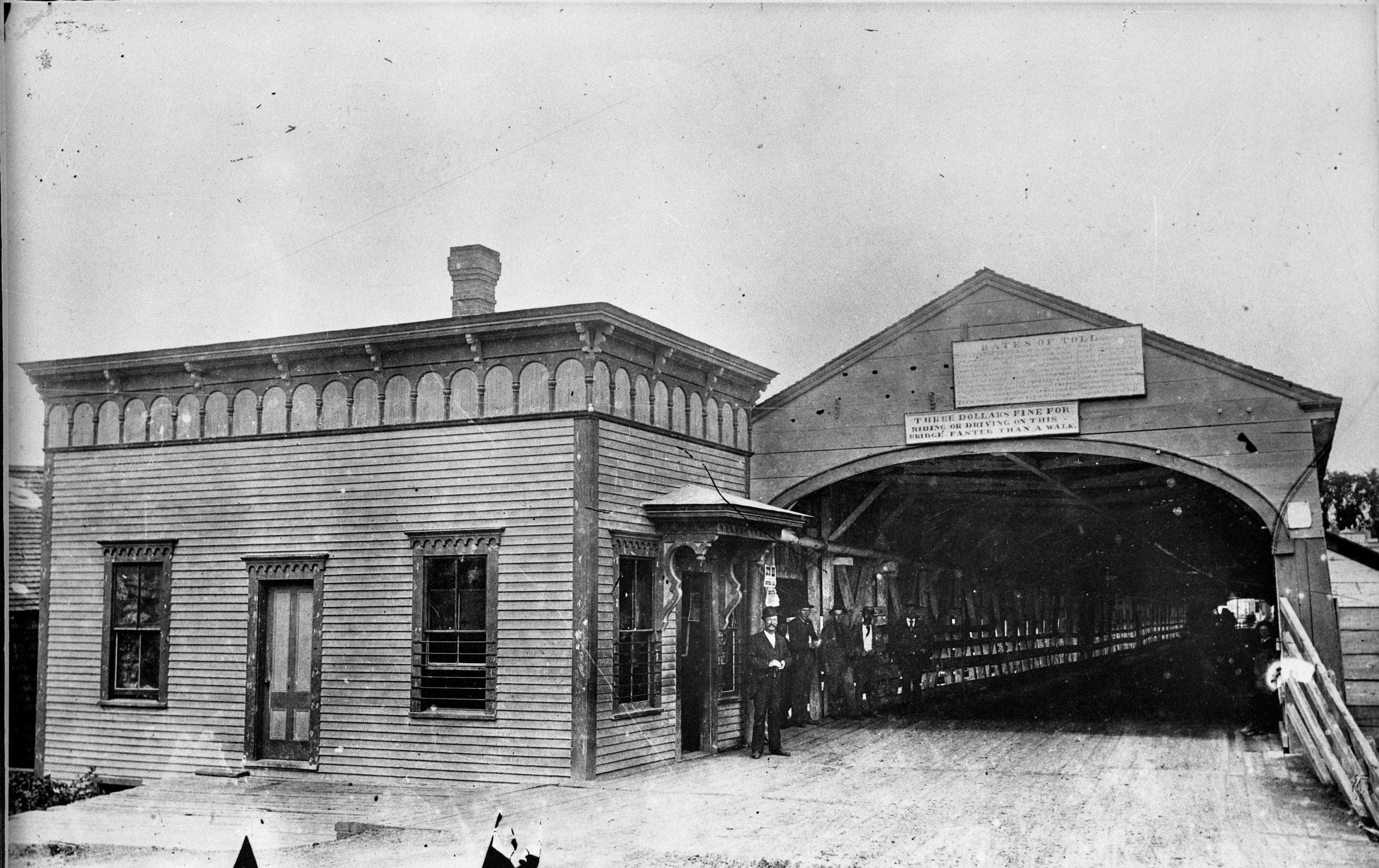
Bridges were soon built at Milltown in 1825 and in 1827 a drawbridge at Ferry Point. A drawbridge was necessary because the Cove on the Canadian side was home to a shipyard and the new ship needed to get downriver. The main bridge linking Calais and St. Stephen at Ferry Point, a covered bridge, replaced the drawbridge in 1844. There was also a bridge built at the Union and one could have concluded the “bridge” issue was solved but this was far from the truth. None of the bridges was owned by the towns. They were owned by bridge companies, groups of wealthy local citizens and sometimes outside investors who built the bridges and charged a toll. The toll was one cent each way, six cents for a single team and 12 cents for a double team and even a cent or two was a lot of money in those days-many people lived entirely by bartering goods and services. A pound of cheese cost 5 cents
The sign above the entry to the covered bridge read “THREE DOLLAR FINE FOR RIDING OR DRIVING ON BRIDGE FASTER THAN A WALK,” and this was enforced quite strictly by the toll keepers as was the toll. Some of the early toll keepers were Archie Agnew, Andrew McCullough, Mr. Bates, and the man in the picture, Jerry Fitzpatrick. These men soon became very unpopular. In the 1840’s a one-eyed collector named Welch was said to be the most hated man in the valley but on his death that honor went to collector Andrew McCullough.
Locals became experts on the personal habits of the tollkeepers who had to eat, perform other bodily functions and sometimes nap. Evading the toll was considered a civic duty and some became adept, others not so skilled. There is the sad story of the girl from St. Stephen who was apprehended by the tollkeeper as she tried to avoid the toll. She was carrying a small infant who she thrust into the hands of the surprised tollkeeper and promptly darted back to St. Stephen. She was never found. The fate of the infant is unknown.
The locals became more and more resentful of the tolls as the years went by as the bridges had paid for themselves several times over. Offers by the public to purchase the bridges, especially the main bridge at Ferry Point, were rejected by the owners who were unwilling to part with a cash cow.

KIng Street St. Stephen looking across to Calais
As citizens on both sides of the border became more frustrated at the bridge owners’ intransigence and greed, demands for a free bridge grew louder. In 1852 a serious attempt was made by Calais and St. Stephen residents and the Province of New Brunswick to build a bridge from the bottom of King Street in St. Stephen directly across the river to North Street in Calais. The proponents cited “the many benefits the people of the surrounding country would derive from direct communications across the river, instead of going round half a mile and paying the high toll enacted by the set of stockholders who would shave the poor man of his last cent to swell their coffers.” The meeting got pretty heated. Colonel Marks, one of St Stephen’s richest men, arose to oppose the bridge for two reasons:
The first is I have wharves and other property above the site of the new bridge which would become worthless, as vessels would not come through a bridge, if they could get freight below. The second reason is the parties who are crying out most for the new bridge are not the farmers of the backcountry, as Mr. Buchanan would feign make you believe, but instead are rum sellers around the public landing, who since the Maine Liquor Law was enforced in Calais, are jealous of the prosperity of their brother rumsellers at the Ferry Point at the end of the Ferry Point Bridge, they having the first chance to supply the citizens of Calais when they get rum dry, which is pretty often, for they are the principal customers of the grog shops on this side of the river, and he (Marks) was sorry that the young gentlemen of Calais could not stay at home and get drunk, and not annoy their neighbors.
Nothing came of this proposal but finally in 1893 the pressure for a free bridge became too powerful for the bridge owners to bear. Streetcars were coming to the valley and the bridges were in a sorry state of repair. While Jumbo the Elephant had successfully crossed the Ferry Point Bridge with the Barnum and Bailey Circus a few years earlier, it was clear the bridge needed to be rebuilt with steel and made free for the streetcars. Still the owners refused to sell except at an extortionate price.
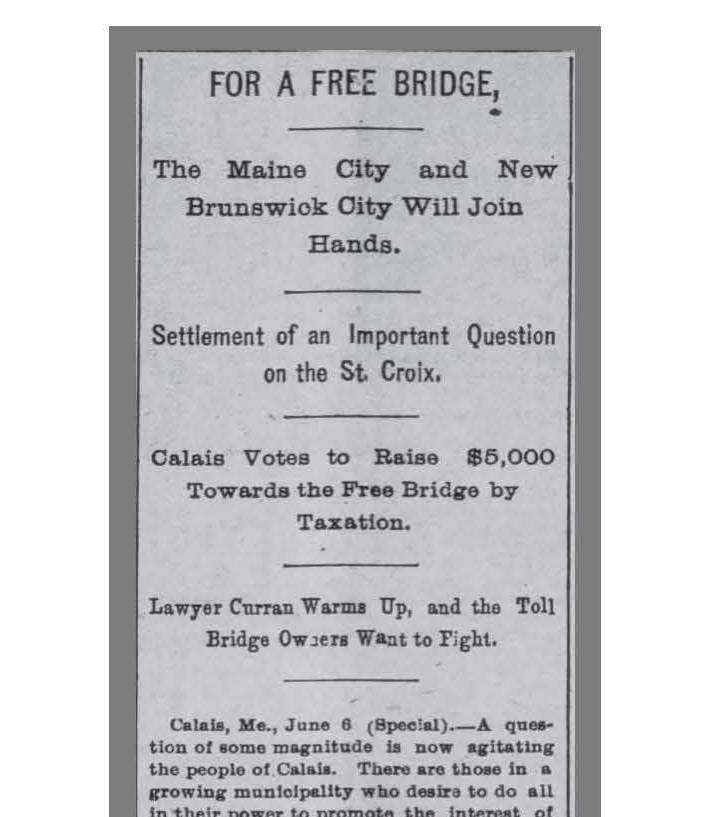
Lewiston Sun June 6 1893
In the summer of 1893, the battle lines had been drawn and as Davis noted in his excellent history of the St. Croix Valley, the bridge owners waged a desperate battle to save themselves. The City of Calais proposed, and the Maine Legislature approved the construction of a new bridge at a location of the City’s choosing across the St. Croix. As the new bridge would be free the owners of the Ferry Point Bridge were checkmated. They had little choice other than to reach an agreement with the city. St. Stephen and Calais bought all the bridges from the owners at a reasonable price and decided to build the new steel bridge on the site of the existing covered bridge. This, of course, had been their intention from the beginning and the town had played its hand brilliantly.
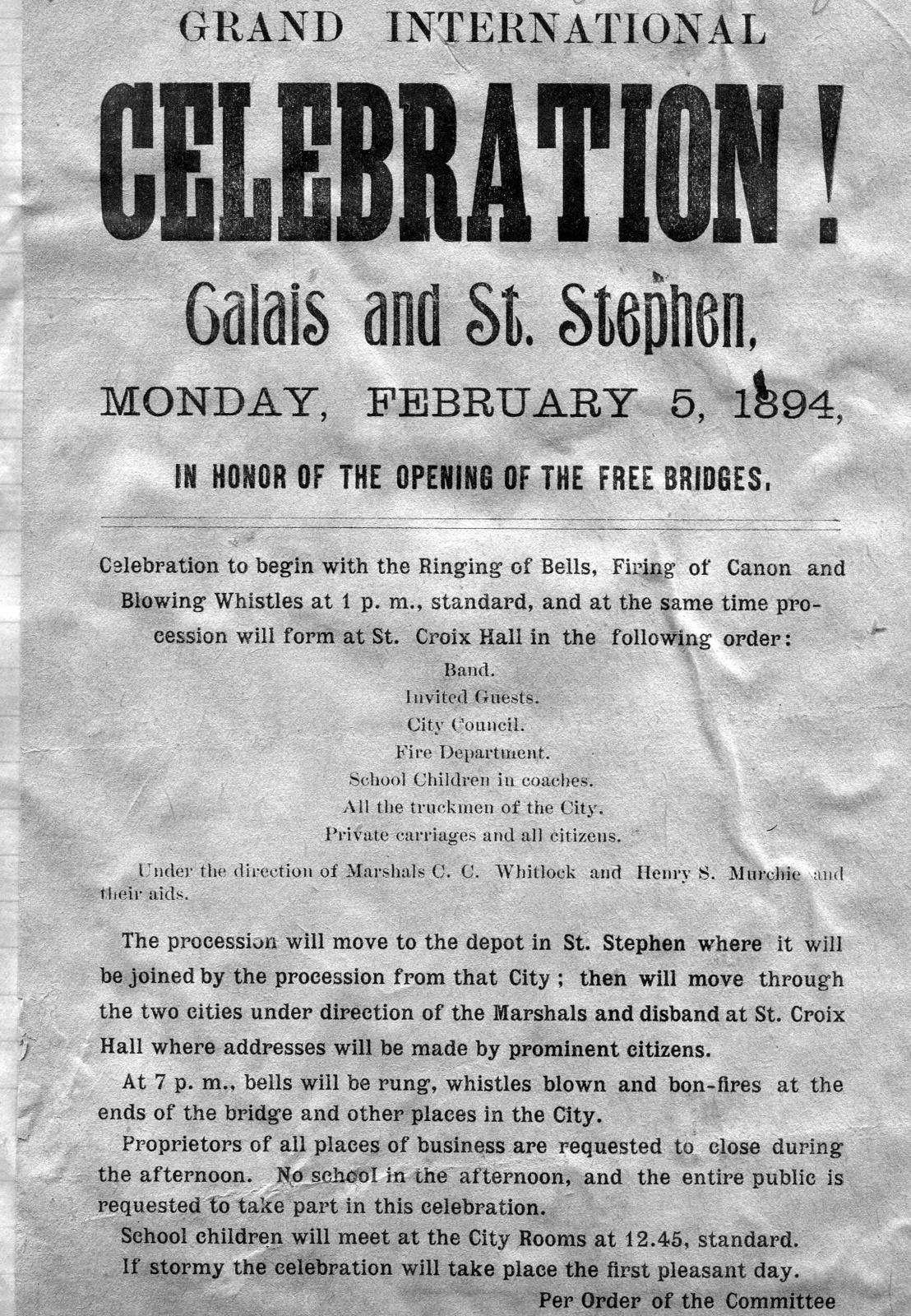
The bridges finally become free
Even before the ink was dry on the sale documents the Calais, St. Stephen and the Milltown councils announced that as of February 5, 1894, all bridges crossing the St. Croix would be free. The citizens were jubilant, and it is unlikely any single event in the history of the St. Croix Valley other than the armistice ending World War 1 and the German surrender in World War Two occasioned such joy.
Hundreds of wagons and thousands of citizens marching on foot through a cold February afternoon and evening paraded from St. Stephen, across the Ferry Point bridge and up Union Street and crossed back into Canada on the now free Union Street bridge. They marched to Milltown New Brunswick and back into the United States across the free Milltown bridge, then down North Street to Calais and a celebration at the Calais Opera House. The procession, according to the Advertiser, was two miles long.
From the St Croix Courier:
St Croix Courier February 8, 1894:
Ferry Point Bridge
It is made free and the people celebrate.
Although the mercury was away down in the basement of the thermometer, and the snow was drifting in a northwest wind, there was a great turnout on Monday afternoon to celebrate the opening of the Ferry Point Bridge for the first time- free of toll. The old bridge itself, for the time being, might be mistaken for a handsome structure, the St. Stephen end being draped with the flags of both nations, and the Calais end hidden in the folds of the Stars and Stripes.
Flags were raised on both sides of the river during the forenoon, and at half past one the sound of guns and bells and steam whistles gave the signal for the formation of the largest procession of sleighs ever seen here. It was formed on Water St. King Street and Union Street, upon the arrival of the Calais and Milltown contingents, with CC Whitlock as chief Marshall and six mounted aides.
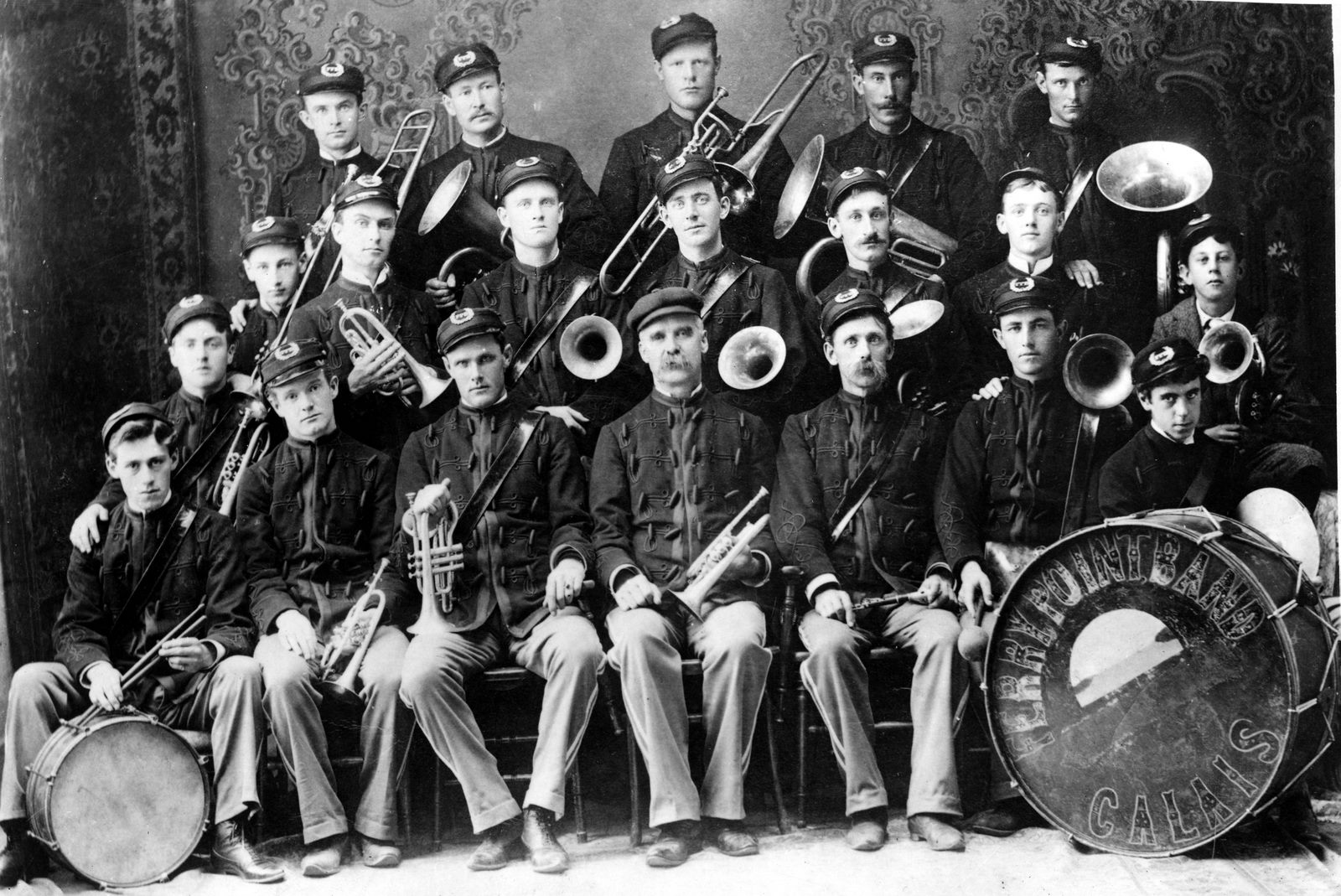
The Ferry Point Band led the procession
At its head was the Ferry Point Band, followed by a handsome vehicle containing provincial secretary Mitchell and the mayors of Calais, St. Stephen and Milltown. The West End band and the fire departments of Calais and Milltown were in the procession. Although the severity of the weather deterred many women and children who would otherwise have helped to swell the ranks, there were upwards of 500 horses and fully 2000 people in line and when extended in moving order, the line was 2 miles long.
Crossing Ferry Point Bridge to Calais they took the shortest way to Milltown across the Union Mills Bridge, which has also been made free, and thence to the upper bridge and down through Calais, Milltown and through the principal streets of the city, disbanding at the Saint Croix Hall. In the hall a number of people were already assembled waiting for the next feature of the program, the presentation address by the honorable Mr. Mitchell, provincial secretary and the honorable George a Boardman mayor of Calais whose appearance was the signal for loud applause.
Doctor Swan took the stage on the platform, beside the Provincial Secretary and Mayor were the ex-mayor McCullough and the board of Alderman of Calais, the Mayor and Council of Saint Stephen, the Mayor of Milltown and the honorable CB Rounds. Judge of the Calais Municipal Court. In his opening remarks, and in a happy vein, the chairman referred to the unique gathering. It was the first time he had ever seen a mass meeting composed of people from both sides of the river. The event which they met to celebrate with something more than simple opening of a roadway. It was the removal of the last trifling obstacle to the free intercourse of the people of the opposite towns, who are bound together by social and business ties and had so many interests in common and an interest in each other’s business prosperity. He suggested that they have a united board of trade, a suggestion which was received with applause.
The chairman then introduced Judge Rounds who said the occasion was indeed remarkable when the people of both sides of the river, young and old, rich and poor, persons of every name and nature joined in the celebration and showed by their presence that they were all pleased with the event of the day- the making free for all future time of the Ferry Point Bridge. He then briefly reviewed the history of the bridges on the Saint Croix…. the times had come when every bridge that crossed the river should be free. (applause) No government should take away our right to free air and sunshine wherever English common law extended. The street, like the air, was free and in Saint Stephen the street reached to the end of the bridge, free to all. In Calais the streets, free to all, reached to the end of the bridge but there for 77 years the toll had existed as an obstruction. Today the bridge has been made free forever!
The Advertiser described the procession in more detail including descriptions of the many floats in the procession including one it named the “Tom and Jerry” which the paper said represented the expulsion of the toll gatherers of that name. Three loud cheers were given at the Opera House for the “Queen, the President and the Free Bridge”.
The significance of February 4, 1894, cannot be understated. It greatly altered the social, economic and political landscape of the St. Croix Valley. For many, especially of the working class, the border ceased to exist and the sense of community in the St. Croix Valley grew stronger.
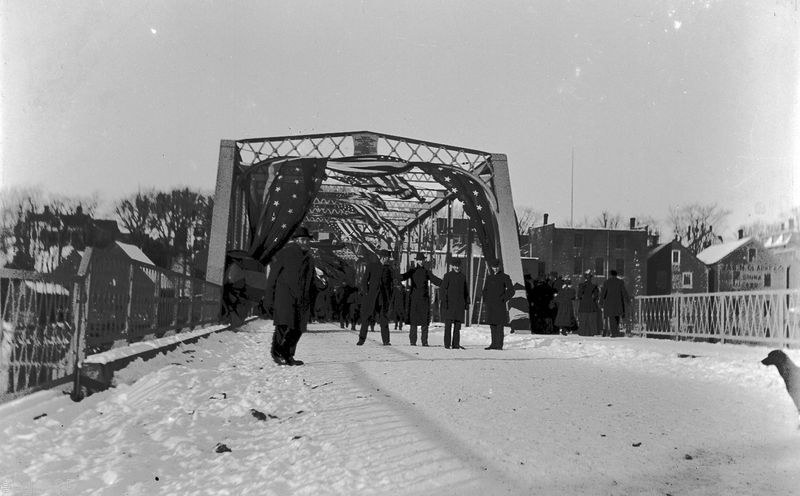
Within a year the steel bridge had replaced the covered bridge and the streetcars began running. The present bridge was built in the mid 1950s.
